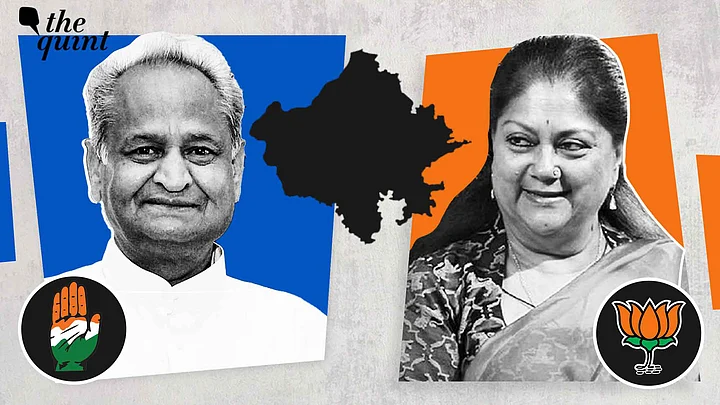Rajasthan culminated voting in the 2023 Assembly Elections on 25 November with a 74.5% voter turnout. The state government has switched between the Indian National Congress and the Bharatiya Janata Party (BJP), a pattern visible in every election since 1998.
All eyes are on the results that will come out on 3 December to see if the Congress will be successful in bucking this trend in 2023.
To understand this patterns, we dived into how Rajasthan’s constituencies have changed their allegiances since 2008.

We classify the state's constituencies into three key categories based on their voting outcomes in the 2008, 2013, and 2018 assembly elections.
1. Anti-incumbency: 44 out of 200 assembly seats in Rajasthan (22 percent) have consistently voted out the ruling party in the last three elections.
2. Strongholds: 33 of 200 (16.5 percent) of seats are ‘strongholds’ for the BJP and the Congress, i.e. these parties have successively won these seats in the last three elections. The BJP has a significantly higher number of strongholds with 28 seats, while the Congress has run a hattrick in only 5 constituencies since 2008. All of these constituencies see significant incumbency, with the ruling candidate often coming back to power.
3. Swing: The difficulty of trying to forecast Rajasthan elections emanates from the remaining 123 ‘swing’ seats (61.5 percent) where there are no discernible party loyalties and trends. For instance, two constituencies, Jhadhol and Jahazpur, have voted counter to the state-wide trend in the last three elections, electing a BJP MLA when the Congress came to power and vice versa. Relative to the rest of India, Rajasthan remains a largely bipolar competition between the Congress and the BJP, with no significant regional challengers. Out of the 123, the Congress and the BJP have oscillated in power in 63 seats while independents and third parties have won in only 58 constituencies in any of the last three elections.

BJP has 5x more strongholds than Congress
The BJP’s larger number of strongholds at 28, along with cyclical effects in the 44 anti-incumbent constituencies give them a big victory margin. Their bigger base of loyal constituencies means that they don't just win, they often win with bigger margins.
But with a large number of swing seats and bipolar competition, the Congress can still snatch victory in a good year, despite only five stronghold seats.
In about 142 seats, a third party has not won any election between 2008 to 2018, representing the bipolarity of the state. The absence of a strong third front could be a potential reason for high anti-incumbency because voters are dissatisfied with the party in power but have no option but to go for the second alternative.
Constituencies closer to Haryana and Uttar Pradesh see more third party competition, while BJP strongholds and bipolarity dominate in regions close to Gujarat.

Mapping this constituency classification shows us that constituencies with high third-party competition are concentrated in the northeastern part of the state.
Independent candidates and third parties are more competitive in high-density constituencies bordering Haryana and Uttar Pradesh. In contrast, the arid, southwestern parts of the state bordering Gujarat and Madhya Pradesh see more bipolar competition between the Congress and the BJP.
Most BJP strongholds are also concentrated here. This illustrates how regional dynamics traverse across state boundaries. Gujarat is a largely bipolar state as well, while Haryana and Uttar Pradesh see significant influence of regional parties.
When the BJP wins, it does so with a larger vote share than the Congress
In stronghold constituencies, the BJP's and the Congress' vote shares vary similarly across elections, with their overall share for a given year being moderated by the overall anti-incumbency.
The difference in vote share between winning and losing parties hovers around the 19-22 percent mark. Even in elections where a party loses the state, they both tend to get ~10 percent greater vote share in their strongholds, indicating equivalently loyal voter bases in these constituencies.

In anti-incumbency seats, the winning party tends to have a 10-12 percent higher vote share, showing a consistent desire for change among voters.
The key difference in voter behaviour lies in swing constituencies. The BJP outperformed the Congress by 12 percent vote share in its winning years, almost guaranteeing a sweep of swing seats. In contrast, the Congress' vote share is only marginally higher, indicating greater competition between Congress and BJP candidates and thus explaining the former's lower seat margins.
This trend is also seen in swing seats with a competitive third party, suggesting that the BJP has a stronger influence in swing constituencies during good election cycles.
Together with anti-incumbency seats, the high vote-share shift of these swing seats towards BJP explains the patterns of anti-incumbency in Rajasthan and why BJP outperforms the Congress to a greater extent when it wins.
Thus, the historical numbers suggest that the BJP is well-positioned to take home the victory on D3 ecember. However, it remains to be seen whether the Congress can defy the odds to change the course of this anti-incumbency trend.
(Surbhi and Ishaan are graduate students studying Economics and Public Policy at Harvard Kennedy School of Government. This is an opinion piece and the views expressed above are the author’s own. The Quint neither endorses nor is responsible for the same.)
(At The Quint, we question everything. Play an active role in shaping our journalism by becoming a member today.)




